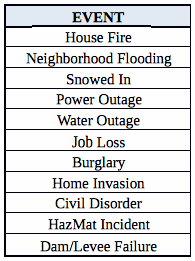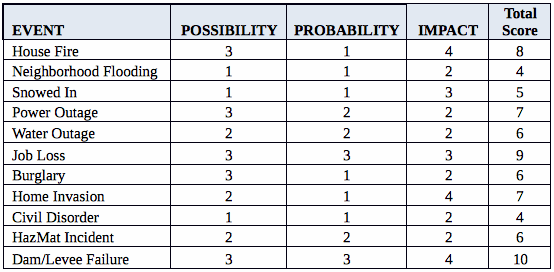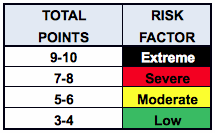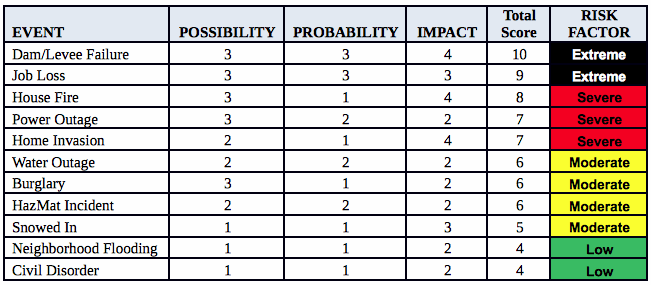
* WHAT SHOULD I BE PREPARING FOR?*
"Be Prepared." We're all familiar with the Boy Scout motto but exactly what you're supposed to be prepared for may not be all that clear. One bit of advice that helped me when I was first getting started and that I still use on a regular basis, was to conduct a Risk Analysis. That simply means figuring out what could happen and how much of an impact on your life it will have if it does. Some people can do this in their head but a lot find it much easier to map out on paper. This is for those of us who like to (or like me, need to) have things organized in an easy to track method. This is really just a tool to help you develop a plan and to prioritize your needs.
Having done plenty of risk analysis in the military I was pretty comfortable doing it but if you've never been exposed to it then it may sound a little intimidating but it's actually not difficult at all. The easiest way to start is to sit down and make a list of things that could go wrong. Just watch the evening news or read the paper for a few days and you should have plenty of ideas - motor vehicle accidents, job loss, burglary, having your car stolen, house fire, power outages, earthquakes, tornados, hurricanes... you get the picture. Don't worry about thinking of every single thing that could possibly happen, this is just to get the ball rolling. You can always add things to your list later - in fact this list should be considered a living document, constantly be updated and revised, changing as your situation and those around you change. A few examples of some things you might have on your list:

This list should be specific to you and your area - obviously if you live in Florida you'll have hurricanes whereas California residents would have earthquakes. Other factors will depend on information more specific to your particular individual situation. For example I live in a subdivision so I'm more concerned about a water main being broken during construction than I am with wildfire. I also live a few miles from train tracks that frequently have chemical transport cars moving on them and there's also a truck route not far from my neighborhood so the possibility of a hazardous materials spill is a reality.
One thing that I'd like to mention is that when you sit down and actually think about everything that could possibly go wrong you may start to notice some anxiety starting to build, that's the normal result from an increase in situational awareness. Everybody realizes that there are a few things that could go wrong and cause a lot of trouble but when you stack them all together in a list like this it can be a little unnerving. Just take a deep breath and relax. After we complete a couple of steps you'll see that some of the more serious sounding problems may not be such a threat after all.
Once you have your threats listed the next step is to figure out how you want to rate each event on how much trouble it would cause for you. I found it much easier to prioritize my needs (which helps me to figure out where my time and money need to go) if I ranked everything according to 3 things - the POSSIBILITY and the PROBABILITY of the event happening and the IMPACT it would have if it were to happen. My score chart has 3 categories each for Possibility & Probability and 4 for Impact:
POSSIBILITY - could this happen to me?
PROBABILITY - how likely is this happen?
IMPACT - what effect would this have on me if it were to happen tomorrow?
By adding up the score for each event you come up with a score from 3 to 10. Here's a sample of how what your chart will look so far. Don't worry if your numbers don't match these, they're just examples and yours should match your situation - for example a dam/levee failure could be a life altering event for somebody who lives in a low lying area a few miles downstream from the dam but only be an inconvenience for somebody also nearby but outside the flood zone.

The total score for each event is your Risk Factor. Exactly what does that mean? Basically you've just ranked out the seriousness of the events you could possibly face - the higher the score the higher the priority of preparing against that event. Although you can categorize your scores anyway that makes sense to you, this is one easy way to do it:

Now by adding that column to your risk chart you can easily see where to start planning. The higher the total score, the higher it should be on your priority list:

That shows that my biggest threats are Dam/Levee Failure and Job Loss followed by House Fire and Power Outage. Those are the first things I'm going to develop a plan for.
That's a very basic overview of Risk Analysis. Hopefully it will give you a place to start. Once you identify the events that you need to prepare for you can then proceed to the next step which is to start figuring out how to address each event.
NightHiker
www.alpharubicon.com
All materials at this site not otherwise credited are Copyright © 1996 - 2011 Trip Williams. All rights reserved. May be reproduced for personal use only. Use of any material contained herein is subject to stated terms or written permission.